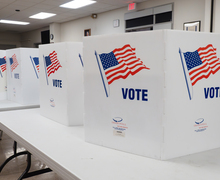Sydor: Time spent in Jordan shines light on cultural discrepancies in gender roles
I am frequently asked what the biggest difference is between Jordan and the United States.
There are many things, both good and bad, but the starkest contrast is the relationship between men and women. Those relationships in Islamic societies have been a divisive issue in the Western world since before 9/11, and they remain important.
From a young age here in Jordan, women are taught that their role is to bear children. For many, it is taught since birth. But I believe that hinders women’s ability to advance in society.
When I talk to Jordanian women about their aspirations after college, their answers most frequently settle on marriage and children rather than starting a career. Of the few exceptions is my Arabic teacher, an unmarried Syrian woman living in Irbid, Jordan.
She says people give her dirty looks when she walks down the street because she is not wearing a wedding ring. However, she proudly strides on as if nothing is wrong, believing that her life is in her control.
The hijab (a headscarf covering a woman’s hair) is another example of societal pressure that Muslim women encounter every day. There has been a significant increase in the number of women wearing the hijab in the last 10 years.
My archaeology professor speculated that only about 30 to 40 percent of women wore the hijab 10 years ago, and those tended to be only the most religious members of society. Now closer to 90 percent of women wear it, and it is the rule — not the exception.
Not all women wear the hijab purely out of religious piety, though.
I was recently at a party with some of my fellow students when a young Jordanian woman walked in wearing a hijab. But she yanked it off and tossed it on a table as soon as the door closed.
I asked her why she wears it in public and not at the party. She explained that with Americans, “I know all of you guys judge me for my personality, not if I wear the hijab or not.” She then explained, “Some of the people in the street will think I am not religious, not clean (not a virgin) or I don’t have morals.”
Some women choose to wear it for personal or religious reasons. Passages in the Quran encourage women to dress modestly and to cover up when around those outside their family. For this reason, many women wear the hijab to express their piety and faith.
This can lead to conflict between the religious men and women who believe that all Muslim women should wear the hijab, and those who choose not to. I have no problem with women who choose to wear the hijab, but I am bothered that a woman’s freedom in something as basic as how she dresses is curbed by societal and religious norms.
Before coming to Jordan, I considered myself to be a cultural relativist, and assumed practices that seemed strange to me could be described by reasonable societal traditions. However, after three months in Jordan, I recognize that cultural norms are not always right, even if they are steeped in history and tradition.
It is wrong that women, even those wearing a hijab, are constantly whistled at when walking alone. At this point, I don’t care who you are or where you’re from: Harassing women is not OK and should not be accepted as normal.
Obviously, this is a particular topic that bothers me and is not a condemnation of Jordanian society as a whole. I will definitely miss the famous Arab hospitality and friendliness.
So as I return to America next week, I will try to remember it all — the good, the bad and the ugly that have made my experience a once-in-a-lifetime opportunity for which I am truly thankful.
Stephen Sydor is a junior international relations major. His column appears every week in Pulp. He can be reached at srsydor@syr.edu.
Published on April 30, 2013 at 12:50 am





